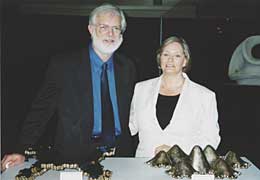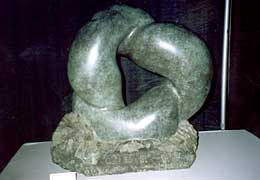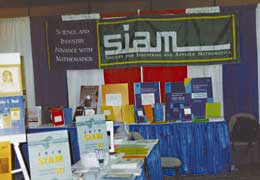
SIAM Annual Meeting, July 2002
One of the highlights of the recent annual meeting of the Society for Industrial and Applied Mathematics (SIAM) was the presentation of the 2002 Joint Policy Board for Mathematics Communications Award to Claire and Helaman Ferguson. The citation states that the Fergusons "have dazzled the mathematical community and a far wider public with exquisite sculptures embodying mathematical ideas, along with artful and accessible essays and lectures elucidating the mathematical concepts." Many of Helaman Ferguson's sculptures were on display in the meeting's exhibit area and both Claire and Helaman were there to answer questions about their work.
Over 1000 people attended the meeting, which took place in Philadelphia from July 8th through 12th and served as a celebration of SIAM's 50th birthday. Among the speakers at the meeting were Rita Colwell, Director of the National Science Foundation, Eric Lander of the Whitehead Institute and the MIT Center for Genome Research, Craig Silverstein of Google, Inc., and Cleve Moler of The MathWorks, Inc.
Colwell gave the meeting's keynote address, titled "Math Matters," and she cited many diverse applications to show the importance of mathematics research. Indeed, she called mathematics "the Esperanto of the sciences." Colwell also talked about education and the challenge to ensure that the United States has a mathematically-literate work force. As an example of the need for better mathematics training, she noted that the National Security Agency can hire only about one-third of its yearly new staff needs.
SIAM's John von Neumann Lecture was given by Eric Lander. Lander's talk was titled "Genomic Information: Driving a Revolution in Biomedicine." Although he is known for his work in biology sequencing the human genome, Lander studied algebraic number theory at Princeton and algebraic combinatorics at Oxford. He said that now is a "wonderful time for mathematicians," due to the need to analyze the tremendous amount of biological data currently being generated. Along with calling for mathematicians to consider work in biology, Lander pointed out how dynamical systems, hidden Markov models and graph theory were used in the Human Genome Project.
A "Mathematical Analysis of Hyperlinks on the World Wide Web" was given by Craig Silverstein. Silverstein provided many details of the mathematics behind Google's PageRank algorithm, especially the linear algebra involved with link analysis on the web. The name, PageRank, was obtained from the company's co-founder, Larry Page, who was often frustrated by early search engines when he would try to search the web for information about himself. Google has 10,000 servers to handle the calculations and information storage required to run its search engine.
In "Fifty Years of Mathematical Software," Cleve Moler offered an historical overview -- from the first software in 1948 (called Highest Factor Routine) to today's Matlab, Maple and Mathematica. Moler said that he was there because of his grades in Numerical Analysis and Advanced Calculus in his junior year at Cal Tech. Although both were passing grades, one was significantly higher than the other.
Visit the SIAM website for more information.





